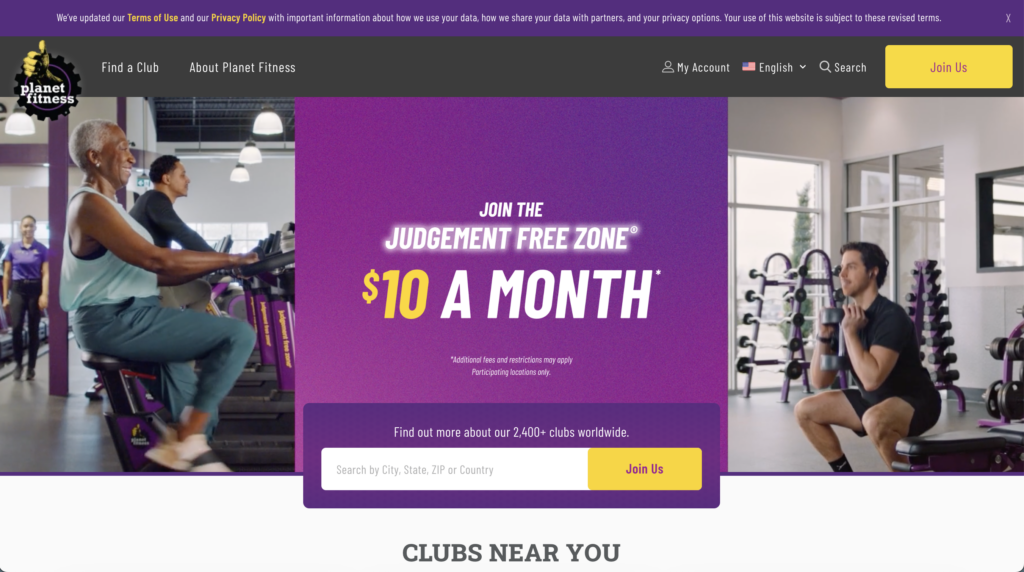Platform
Solutions
Industries
Compare
Resources
Posted by on January 17, 2025 — Updated on January 17, 2025
Around 20% to 25% of Planet Fitness members consistently use their memberships, reflecting industry-wide trends where a significant percentage of gym memberships go unused.

The Planet Fitness business model is designed to attract a wide range of customers, including both frequent gym-goers and those new to fitness. However, studies and gym membership statistics indicate that only a small percentage of gym members actively use their memberships. On average, it’s estimated that around 20% to 25% of Planet Fitness members consistently attend the gym. The rest either use their membership infrequently or not at all. Here’s a table with key Planet Fitness statistics:
| Statistic | Value | Year |
|---|---|---|
| Total Members | 19.6 million | Q1 2024 |
| Membership Growth | 1.7 million | 2023 |
| Total Locations | 2,599 | Q1 2024 |
| System-wide Same Store Sales Increase | 6.2% | Q1 2024 |
| Percentage of Americans (15+) who are members | 6% | 2023 |
| Franchised Locations | ~90% | 2023 |
| New Stores Opened | 165 | 2023 |
| Corporate-owned Locations | 18 | 2023 |
| Countries with Planet Fitness presence | 7 (US, Canada, Panama, Mexico, Australia, Puerto Rico, District of Columbia) | 2023 |
It’s important to note that specific data on how often members use their membership or the average number of members per location is not provided, except for estimates. However, some insights can be inferred:

While specific data on Planet Fitness membership usage patterns is not available, these Planet Fitness statistics demonstrate Planet Fitness’s strong market position and continued growth in the fitness industry. This low usage rate aligns with the percentage of gym memberships that go unused industry-wide, which hovers around 50% to 60%. For Planet Fitness, this model works well due to its affordable pricing structure and large membership base, allowing it to profit even with low attendance rates.
Even if they may have a different gym business model, gym owners can learn a lot from Planet Fitness marketing.

Things like gym referral marketing are just one of many gym marketing ideas that Planet Fitness has down to a science.
Ready to see how the best gym management software can help you increase gym profitability, improve gym customer service, and increase gym retention rates?



Understanding how the Planet Fitness business model thrives despite low attendance rates can provide valuable insights for other gym owners. Below are key aspects of their strategy that encourage low usage while maintaining high profitability.
Planet Fitness attracts members with its low-cost pricing structure. The Planet Fitness membership cost Black Card is approximately $24.99 per month, while the standard membership is as low as $10 per month. These prices make it easy for members to retain their memberships, even if they rarely visit.
The “Judgement-Free Zone” is a core element of the Planet Fitness brand. This concept appeals to casual exercisers who may feel intimidated by traditional gyms. By creating an inviting and non-intimidating environment, Planet Fitness attracts first-time gym-goers who may be less likely to attend regularly.
This marketing approach ensures a steady influx of new members who are drawn to the low-pressure atmosphere, even if they don’t consistently utilize their membership.
Planet Fitness gyms are designed to accommodate a large number of members. By relying on the fact that many members won’t attend frequently, they maintain high membership numbers without overcrowding.
This strategy minimizes wear and tear on equipment while maximizing profitability per square foot, a model that works well for their business structure.
The percentage of gym memberships that go unused is a common issue across the fitness industry. This phenomenon reflects a combination of human behavior and gym business strategies.
Several factors contribute to this trend:
These trends highlight the importance of gyms engaging with members to encourage consistent attendance and usage.
Understanding global gym attendance trends provides additional context for how fitness businesses operate worldwide. Attendance rates vary significantly across different markets, reflecting cultural attitudes and economic factors.
Globally, about 20% of the population holds a gym membership, but attendance rates vary significantly. In some regions, like North America, attendance is higher due to fitness culture and accessible gym options. However, worldwide attendance often follows the same pattern as Planet Fitness, with many memberships going unused.
This highlights the universal challenge of turning memberships into consistent gym usage and underscores the need for innovative engagement strategies.
For gyms looking to improve attendance and engagement, the best gym management software is a critical tool. Platforms like Exercise.com help gyms streamline operations and enhance member experiences.
Exercise.com enables gyms to break away from the low-attendance model and create a culture of consistent fitness participation.
The Planet Fitness business model succeeds because it’s built around attracting a large number of low-cost memberships, knowing many will go unused. For Planet Fitness:
This strategy works well for Planet Fitness but highlights an industry-wide challenge: how to balance affordability with active member engagement.
While the Planet Fitness business model capitalizes on low attendance, other gyms can differentiate themselves by focusing on engagement and value. Using tools like Exercise.com, gyms can boost attendance, retain members, and provide a superior experience. Whether analyzing gym membership statistics by month or addressing the percentage of gym memberships that go unused, Exercise.com equips gym owners with the insights and tools needed to succeed.
Planet Fitness also does an excellent job of implementing gym win-back campaigns (should their members actually cancel).

If you’re ready to improve your gym’s engagement and operations, schedule a demo with Exercise.com today and see how the best gym management software can transform your business.


It’s estimated that about 50-60% of Planet Fitness members actively use their memberships. This aligns with industry trends where a significant portion of gym memberships go underutilized, contributing to the profitability of high-volume, low-cost gyms like Planet Fitness.
Approximately 18% of Americans are gym members, but only about 50% of these members attend the gym regularly. This means a large percentage of memberships remain underutilized, highlighting the importance of member retention strategies.
The Planet Fitness business model is based on a high-volume, low-cost membership strategy, offering affordable memberships with a focus on casual gym-goers. They maximize profitability by limiting overhead, appealing to non-traditional gym users, and relying on a large base of infrequent attendees.
Read More: How does the Planet Fitness business model work?
An estimated 30-40% of Gen Z actively participates in fitness activities, with many favoring gym memberships and boutique fitness studios. Their fitness habits often include group classes and hybrid fitness options that incorporate technology.
Between 60% and 70% of gym memberships go unused, a statistic that highlights the challenge of member engagement and retention in the fitness industry.
Read More: What percentage of gym memberships go unused?
Approximately 50% of new gym members quit within the first six months, often due to a lack of motivation, unclear fitness goals, or poor onboarding experiences.
About 20-30% of gym members use their memberships regularly, with active attendance varying by gym type and membership demographics.
Read More: What percentage of gym memberships go unused?
The average Planet Fitness location serves 6,000 to 10,000 members, emphasizing its high-volume, low-cost business model designed to attract casual gym-goers.
Daily guest visits at Planet Fitness vary but typically range from 500 to 1,000, depending on the location, size, and peak hours.
Planet Fitness franchise owners earn an average annual profit of $50,000 to $100,000 per location, with some earning more in high-traffic areas. Profitability depends on membership volume, overhead costs, and operational efficiency.
Read More: How much does the average Planet Fitness owner make?
The best software for running a gym is Exercise.com, offering an all-in-one solution for scheduling, payment processing, membership management, and fitness programming. Its customizable features make it ideal for gyms of all sizes, enabling streamlined operations and improved member engagement.


 Tyler Spraul
Tyler Spraul